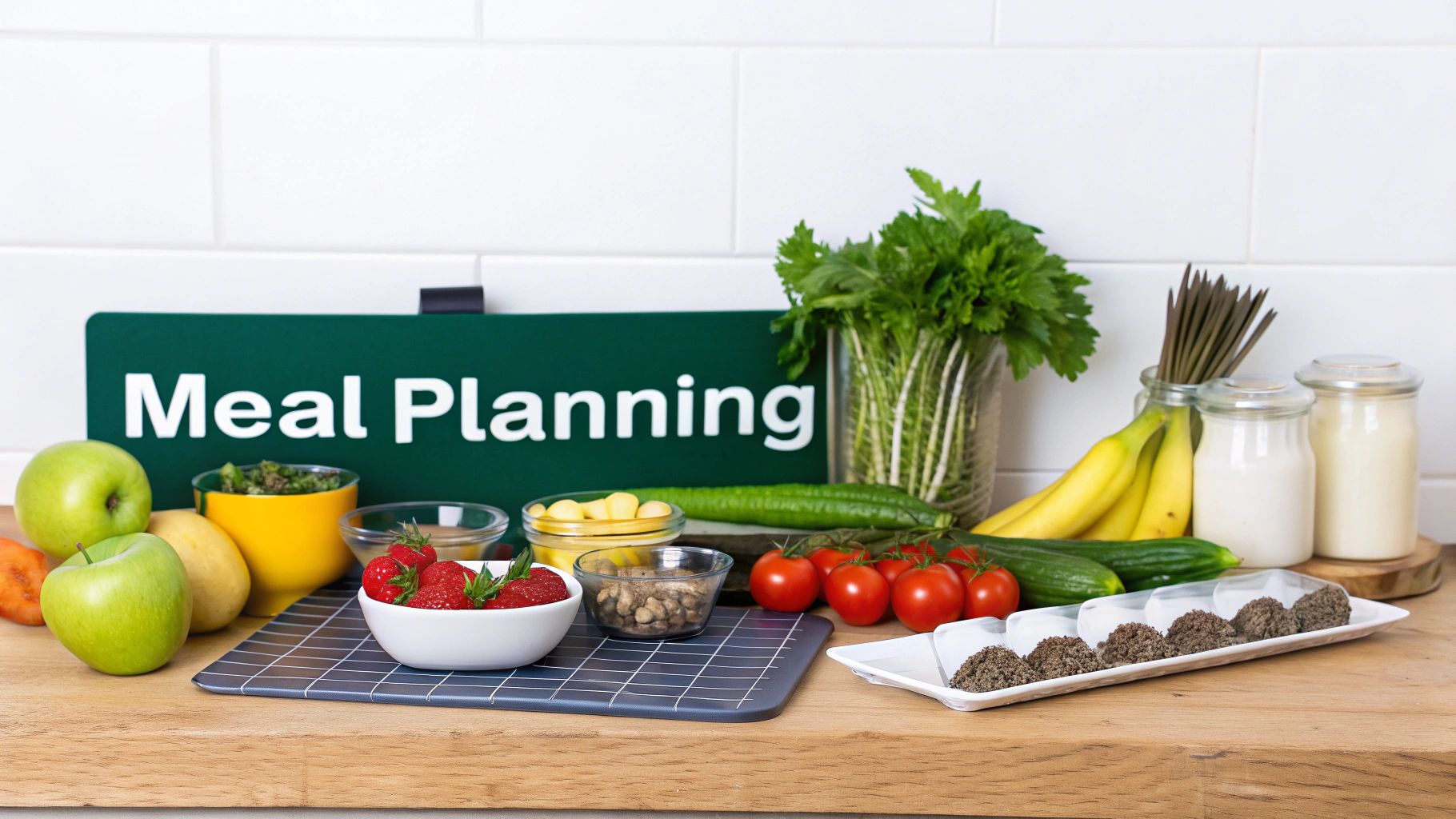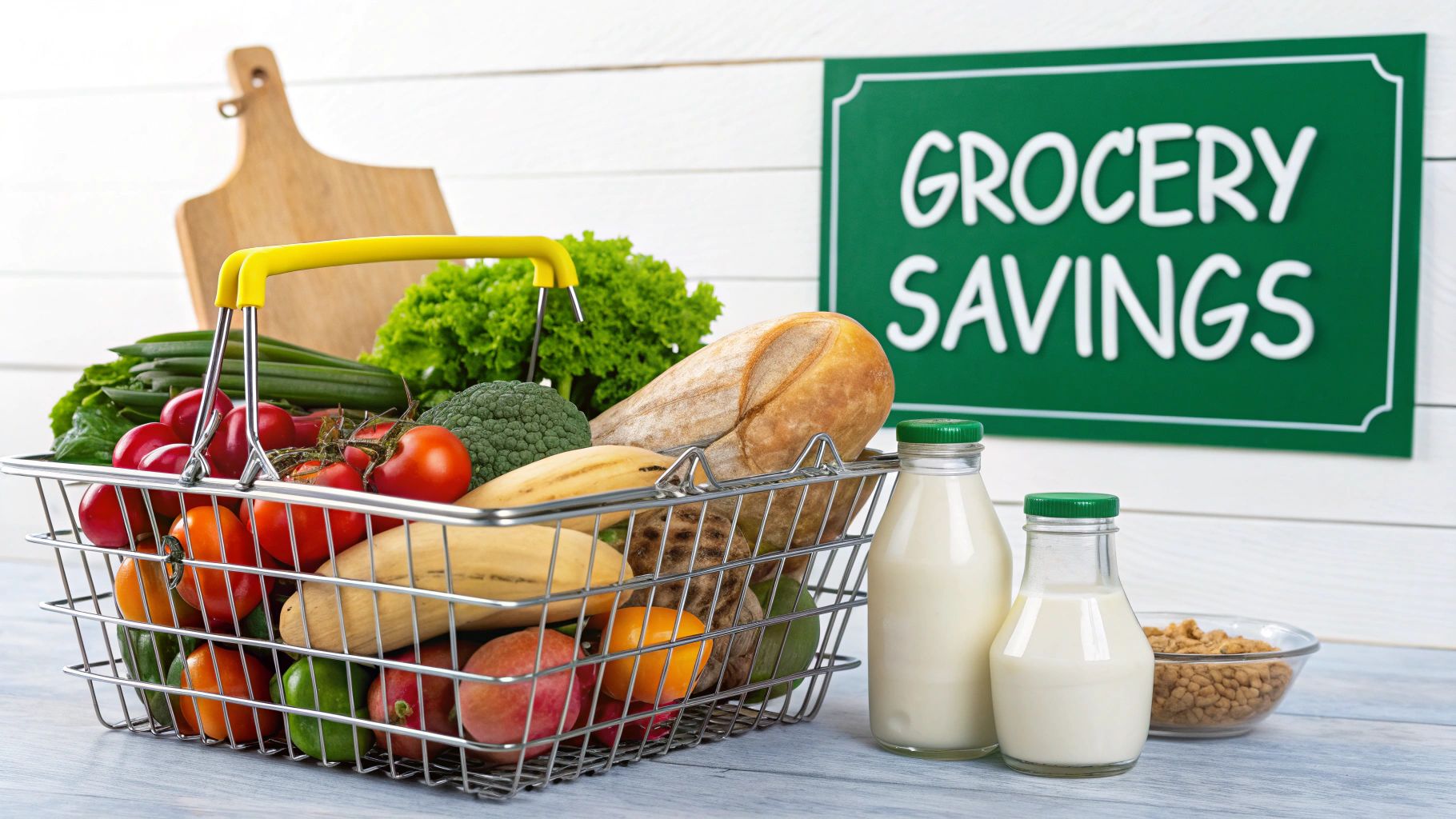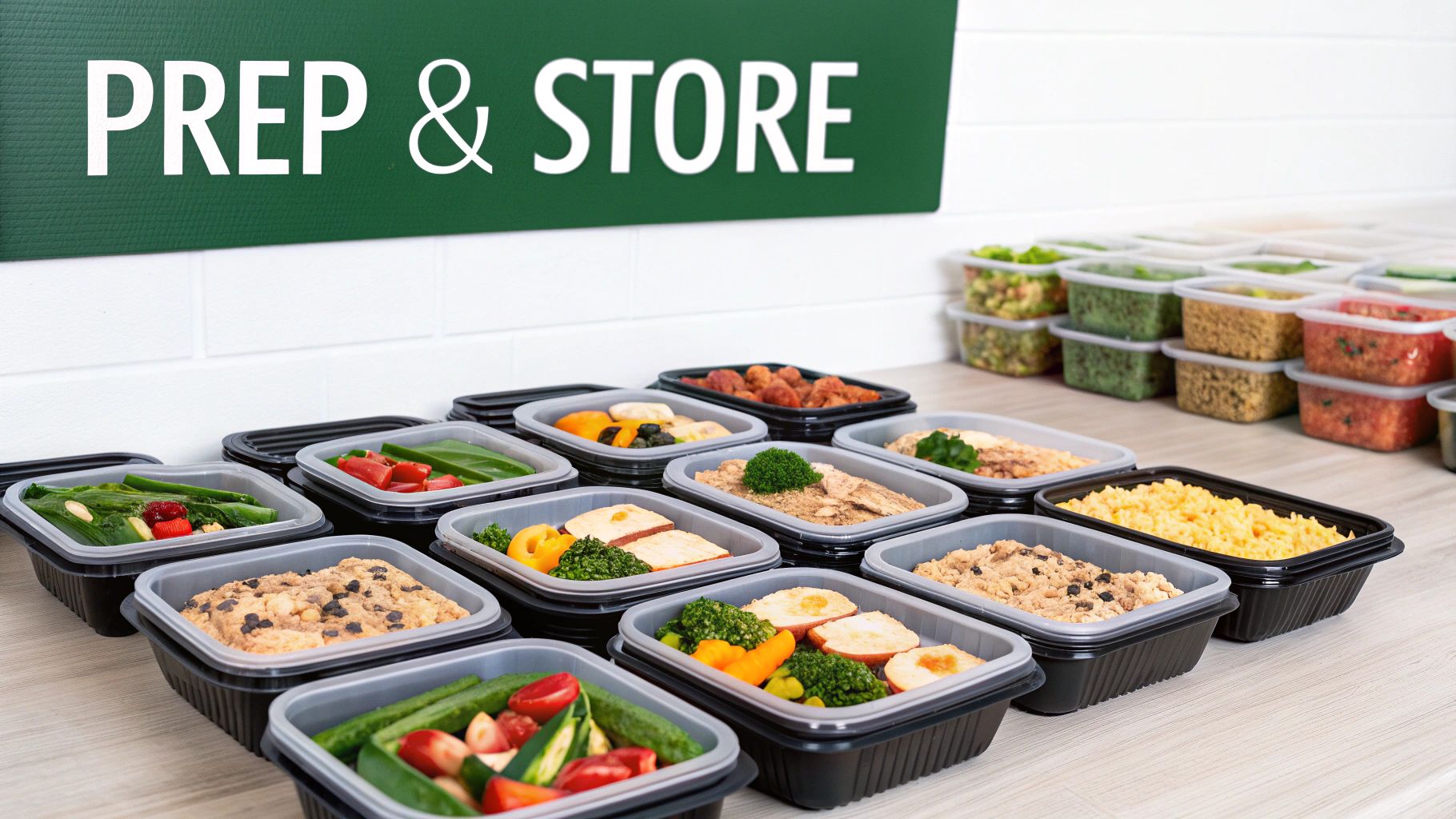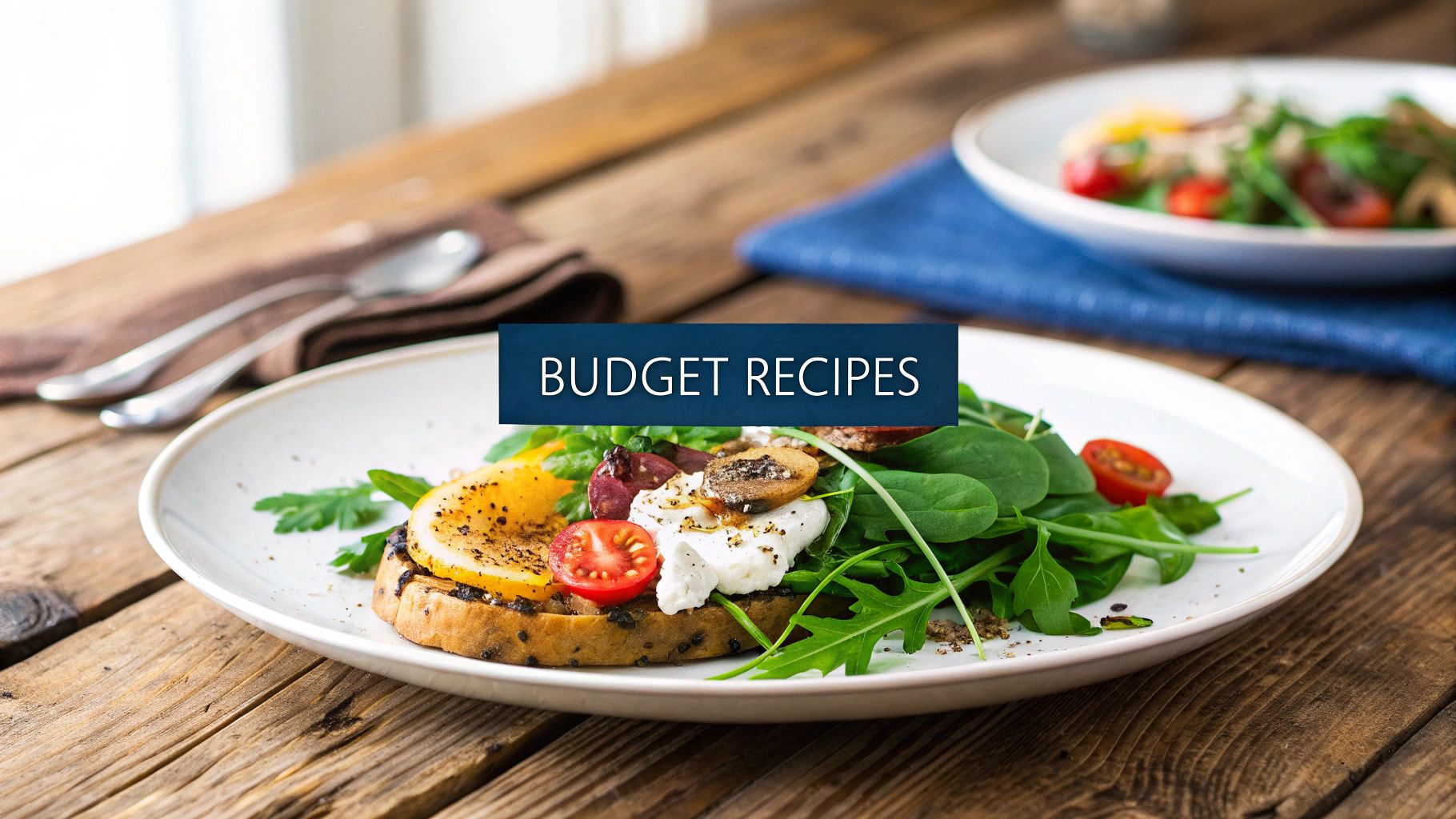Cheap Meal Planning Made Easy on a Budget
Discover how cheap meal planning can slash your grocery bill while keeping meals delicious. Transform your food spending today!
Ready to Simplify Your Meal Planning?
Get personalized meal plans and grocery lists automatically matched to your macro targets.

Cheap Meal Planning Made Easy on a Budget
The Real Impact of Strategic Meal Planning

Saving money is great, right? But what if I told you that cheap meal planning isn't just about pinching pennies? It's about seizing control of your food budget and boosting your family's nutrition. In these times of unpredictable grocery prices, planning your meals is more than just a good idea – it's a necessity. This mindful approach to eating is changing the game for families, turning a helpful hint into a must-do practice.
Many families are discovering the power of planning. With a little forethought, they're slashing their monthly food bills without sacrificing deliciousness or variety. This proactive strategy allows for greater financial stability and sets the stage for healthier eating habits. It's a win-win!
Beyond the Budget: The Perks of Planning
Cheap meal planning offers a treasure trove of advantages beyond a smaller grocery bill. It’s a secret weapon for improved nutrition. By planning ahead, you're more likely to choose wholesome, unprocessed foods over quick-fix processed items.
Additionally, meal planning is a champion at reducing food waste. When you know exactly what you need and when, overbuying and spoiled food become things of the past. This conscious approach to consumption not only saves money but also gives the environment a high five. It means families are enjoying fresher, healthier meals, minimizing waste, and getting the most bang for their grocery buck.
Interestingly, a growing trend in cheap meal planning is the comeback of home-cooked meals. It's a direct response to rising restaurant prices and economic pressures. Want to delve deeper into this culinary shift? Check out this fascinating article: Home Cooking and Economic Constraints.
Debunking the Myths of Affordable Eating
Let's face it, there are some misconceptions floating around about cheap meal planning. Some think it means boring, repetitive meals. But guess what? That couldn't be further from the truth. With a dash of creativity and a pinch of planning, budget-friendly meals can be just as exciting and flavorful as their pricier counterparts.
Think versatile ingredients like beans, lentils, and rice. They’re the chameleons of the culinary world! These budget-friendly staples can be transformed into a global feast, from spicy Mexican lentil stews to aromatic Indian curries. It's a world of culinary adventure without breaking the bank.
Measuring Your Success
Tracking your progress is like giving yourself a high five for your smart choices. While the most obvious measure is the money saved, there's more to the story. How much less food are you tossing each week? Are you dining out less and cooking up a storm at home? Are you loading up on more fruits and vegetables?
These non-monetary benefits are powerful indicators of your success. By looking at the big picture, you'll gain a deeper understanding of the positive ripple effects of cheap meal planning on your life. It's about more than just money; it's about a healthier, more sustainable lifestyle.
Building Your Cost-Cutting Kitchen Foundation

Want to become a meal-prepping magician and a budget-savvy superhero? It all starts with a well-stocked and organized kitchen. This isn't just about neatness; it's about having the right ingredients at your fingertips and the tools to make the most of them, transforming everyday meals into culinary masterpieces without breaking the bank.
Pantry Power: Stocking Up on Staples
Rice and beans? Sure, they're budget-friendly classics. But let's think outside the can (or bag, as it were). Adding a few powerhouse ingredients like lentils, oats, and canned tomatoes can unlock a world of affordable meal possibilities. These humble heroes are incredibly versatile and form the base for countless delicious dishes. Lentils can morph from a hearty soup into a zesty taco filling faster than you can say "dinner's ready!"
Organized for Savings: Preventing Food Waste
Ever find yourself tossing out wilted greens or forgotten leftovers? A well-organized fridge and pantry are your secret weapons against food waste. Did you know that 30-40% of the U.S. food supply ends up in the trash? That's a lot of wasted money! A simple "first in, first out" system can make a huge difference. Older items up front, newer items in the back – it's that easy. You'll not only reduce waste but also stretch your budget further.
Tools of the Trade: Smart Kitchen Investments
While a fancy spiralizer might look cool on your countertop, some basic kitchen tools offer far more value when it comes to budget meal planning. A good set of knives, a sturdy cutting board, and some airtight containers are your true MVPs (Most Valuable Pantry-mates). These essentials make prepping and storing food a breeze, keeping your ingredients fresher for longer.
To help illustrate how to maximize value in your pantry, let's take a look at a cost comparison of some key staples. This table breaks down the average cost, cost per serving, shelf life, and a versatility rating to help you make informed choices.
Pantry Staples Cost Comparison: A breakdown of essential pantry ingredients showing cost per serving and shelf life to illustrate maximum value items
| Ingredient | Average Cost | Cost Per Serving | Shelf Life | Versatility Rating |
| Dried Lentils | $2.00/lb | $0.25 | 2+ years | 5/5 |
| Dried Beans | $1.50/lb | $0.20 | 2+ years | 4/5 |
| Rice (white, long grain) | $1.00/lb | $0.10 | 2+ years | 3/5 |
| Rolled Oats | $3.00/container | $0.20 | 1 year | 4/5 |
| Canned Tomatoes | $1.50/can | $0.50 | 1+ year | 4/5 |
As you can see, items like lentils and beans offer exceptional value with a long shelf life and a high versatility rating. Incorporating these into your meal planning can significantly impact your grocery budget.
Planning Your Approach: Systems for Success
Whether you're a pen-and-paper planner or a digital devotee, finding a system that works for you is key. A simple notebook can be just as powerful as a sophisticated app like Meal Flow AI. The real magic ingredient is consistency. Committing to a plan, no matter how simple, streamlines the process and helps you stay on track.
Realistic Budgeting: Setting Achievable Goals
Creating a realistic food budget is crucial for long-term success. Consider your household size, dietary needs, and local grocery prices. A family of four will likely have different needs than a single person. Researching average food costs in your area can provide a helpful starting point. This allows you to set achievable goals and celebrate your wins along the way.
Grocery Shopping Strategies That Actually Save Money

Let's face it, the grocery store can be a minefield for your budget. Supermarkets are practically designed to make you overspend. But don't worry, understanding their tricks is half the battle. We're diving deep into how to outsmart those consumer traps and keep your wallet happy.
Decoding the Supermarket Layout
Ever wonder why the essentials, like milk and bread, are always at the back? It's a classic supermarket strategy. They want you to wander past all those tempting displays and impulse buys. And those end-cap displays? Prime real estate for higher-profit items. Knowing this helps you avoid unnecessary purchases and conquer your cheap meal planning goals.
Navigating the Aisles with Purpose
A shopping list based on your meal plan is your secret weapon. It keeps you laser-focused. And here's where apps like Meal Flow AI can be a game-changer. By automatically generating shopping lists from your meal plan, Meal Flow AI saves you time and keeps those impulse buys at bay.
Another pro tip? Stick to the store's perimeter. That's where the fresh produce, dairy, and meat usually hang out. Less exposure to the processed food and snack temptations lurking in the inner aisles.
Smart Bulk Buying
Bulk buying can be a great way to save, but only if you're strategic. Items like rice, beans, and oats are perfect for stocking up. But beware of perishables. Bulk buying only works if you can use it all before it goes bad. A giant bag of discounted potatoes isn't a bargain if half of them end up sprouting in your pantry.
Store Brands vs. Name Brands
Don't underestimate store brands. Often, they're just as good as name brands, but significantly cheaper. This is especially true for pantry staples. But for some items, that name brand might be worth the extra cash due to taste. Maybe that name-brand coffee is your non-negotiable morning pick-me-up.
Seasonal Shopping
Eating with the seasons isn't just trendy. It's budget-friendly. Peak supply and lower prices go hand-in-hand with seasonal fruits and vegetables. So, incorporating them into your meal plan is a win-win: delicious and budget-friendly.
Coupons and Loyalty Programs
Digital coupons and loyalty programs can definitely save you money. But don't go overboard. Chasing tiny discounts can be a time suck. Pick a few programs that fit your shopping habits and stick with them.
The meal planning industry is booming, driven by the demand for budget-friendly solutions. Want to learn more? Check out the growth of the meal planning market: Find more detailed statistics here. So, embrace a strategic approach to grocery shopping. You can reduce your spending and make that cheap meal plan a delicious reality.
Meal Prep Techniques That Don't Consume Your Weekend

Cheap meal planning gets a whole lot easier with some smart meal prepping. But the thought of spending your entire weekend chained to the stove? No thanks! This section offers some clever batch cooking methods to maximize efficiency without turning your weekend into a kitchen marathon. These tips and tricks are borrowed from busy professionals and parents who have successfully conquered meal prep amidst their hectic schedules.
Batch Cooking Basics: Maximizing Your Time
Think of batch cooking as your weekday mealtime superpower. This isn’t about making seven days' worth of the same dish (boring!). It’s about strategically prepping components that you can mix and match throughout the week.
For example, roasting a giant pan of veggies, cooking a massive batch of grains like quinoa or rice, and grilling a bunch of chicken breasts gives you the building blocks for countless meals. Then, simply jazz them up with different sauces, spices, and fresh ingredients to keep things interesting.
Freezer-Friendly Foods: Stockpiling for Success
Your freezer is your best friend in the quest for cheap and easy meal planning. The key is knowing which foods freeze well so you can avoid waste and maximize your prep time.
Soups, stews, chili, and sauces are all freezer superstars. Portion them out into individual containers for grab-and-go lunches or dinners that are ready in a flash. Just remember that foods with high water content, like salads and some fruits, don't love the freezer so much.
The Art of Repurposing: Leftover Magic
Repurposing is another game-changer for efficient and affordable meal planning. One basic preparation can transform into a whole new meal the next day! Roasted chicken can become chicken salad sandwiches for lunch and then star in chicken tacos for dinner. This prevents leftover fatigue and stretches your ingredients to the max. It’s like a fun culinary puzzle – how many dishes can you create from your basic components?
Addressing Psychological Barriers: Staying Motivated
Let’s be real, motivation can be tricky. The secret? Start small! Begin by prepping just one or two meals a week, then gradually increase as you get the hang of it. Treat your prep sessions like any other important appointment – schedule them in advance to seamlessly integrate them into your routine. Meal Flow AI can even lend a hand by generating personalized meal plans and shopping lists, taking some of the mental load off your plate.
Weekend Prep Plan Example: 2-3 Hour Power Session
Here's a sample weekend prep plan to show you just how doable this whole thing is:
- Hour 1: Roast a massive tray of mixed vegetables (broccoli, carrots, peppers, onions) and cook a big batch of quinoa.
- Hour 2: Whip up a giant pot of lentil soup and portion it into individual containers for freezing.
- Hour 3: Grill or bake several chicken breasts and hard-boil a dozen eggs for quick snacks and meal additions.
This prep work sets you up for numerous meals throughout the week, saving you time and money while ensuring you have healthy, tasty meals at your fingertips. With these meal prep strategies, cheap meal planning becomes not only affordable but also enjoyable and sustainable. You got this!
Budget-Friendly Recipes That Actually Taste Amazing
So, you're tired of sad, boring budget meals? Yeah, we get it. This section is dedicated to delicious, wallet-friendly recipes that will make your taste buds sing without breaking the bank. Forget rigid recipes! We're diving into adaptable templates – think of them as your meal-planning blueprints. Swap in ingredients based on what's on sale and get creative in the kitchen while saving money. It's a win-win!
Global Inspiration: Flavor Without the Frills
Believe it or not, some of the world's most flavorful cuisines are also the most budget-friendly. Think robust Latin American bean dishes, colorful Mediterranean grain bowls, and speedy Asian-inspired vegetable stir-fries. These cuisines rely on inexpensive, nutritious ingredients, proving that cheap eats don't have to be boring eats.
A simple pot of beans can transform into a flavor fiesta with a few spices, chopped onions, and peppers. Likewise, a basic grain bowl becomes a Mediterranean masterpiece with olives, a sprinkle of feta cheese, and a squeeze of lemon. Embrace simplicity and let those fresh, affordable ingredients shine!
Chef Secrets: Maximizing Flavor on a Dime
Professional chefs have secrets for making inexpensive ingredients taste amazing. One trick? Strategic use of premium ingredients in small amounts. A sprinkle of Parmesan, a dash of smoked paprika, or a pinch of saffron can elevate a dish without breaking the bank.
Another secret weapon? Layering flavors. Toasting spices, caramelizing onions, or roasting vegetables brings out their natural sweetness, building complexity with simple techniques. These small touches make a world of difference.
Plant-Forward Power: Nutrition and Savings
Plant-forward meals starring fruits, vegetables, legumes, and grains are naturally budget-friendly and nutritional powerhouses. Packed with vitamins, minerals, and fiber, they’re easier on your wallet than meat-centric meals.
This doesn't mean going full vegetarian (unless you want to!). Even reducing meat consumption by a few meals a week can significantly impact your grocery bill. Meal Flow AI can help you create personalized plant-forward meal plans, making the transition smoother.
Scaling and Freezing: Making the Most of Your Meals
Cooking for one or a family of five? No problem! These recipes are adaptable to any household size. Just adjust the quantities. Batch cooking is a breeze – double or triple a recipe and freeze portions for future meals. Soups, stews, and casseroles freeze beautifully, making for quick and easy meals later on.
For optimal freezing, use airtight containers and label them with the date and contents. This prevents freezer burn and keeps your freezer organized. Proper freezing locks in flavor and texture, making budget meal planning even more efficient.
Visualizing Savings: Cost Breakdowns
To demonstrate the real savings, we've included a cost breakdown for each meal, showing the approximate price per serving. Compare the cost of homemade meals to takeout or restaurant equivalents and prepare to be amazed!
Let's take a look at a detailed comparison of homemade meals versus their store-bought or takeout counterparts. This table will break down the cost savings and prep time, highlighting the advantages of cooking at home.
| Meal Type | Homemade Cost | Store-Bought/Takeout Cost | Savings | Prep Time |
| Lentil Soup | $1.50 | $7.00 | $5.50 | 30 minutes |
| Chicken Stir-fry | $2.00 | $10.00 | $8.00 | 20 minutes |
| Bean Burritos | $1.00 | $8.50 | $7.50 | 25 minutes |
| Pasta with Marinara Sauce | $0.75 | $9.00 | $8.25 | 15 minutes |
As you can see, the cost savings are significant. Enjoy delicious, home-cooked meals and keep more money in your pocket!
Digital Tools That Transform Your Cheap Meal Planning Game
Staying organized and inspired while sticking to a tight food budget can feel like a tricky balancing act. But don't worry, a handful of digital tools can make cheap meal planning a breeze, becoming your secret weapons in the quest for affordable and tasty eats. From adaptable meal planning apps to clever grocery shopping assistants, the power of technology is at your fingertips!
Meal Planning Apps: Your Personalized Budget Chef
Meal planning apps are like having a personal chef who understands your budget. They're designed to simplify everything, from dreaming up meal ideas to making grocery lists. Many offer useful budget tracking features, letting you set spending limits and see how you're doing. Some even link up with local grocery store sales flyers, recommending meals based on discounted ingredients.
For example, Meal Flow AI not only crafts personalized meal plans but also automatically generates Instacart shopping lists for effortless grocery delivery. This stops those impulse buys and helps you stick to your budget. Finding an app that syncs with your spending habits can be a total game-changer for cheap meal planning.
Recipe Search Engines: Finding Truly Affordable Options
Recipe search engines are a goldmine of meal inspiration. However, uncovering truly budget-friendly recipes often requires a bit of detective work. Using specific filters like "budget," "pantry staples," or "cheap eats" can help narrow your search.
Also, pay close attention to the ingredient list. A recipe labeled "budget-friendly" might still sneak in some pricey specialty items. Focus on recipes that make the most of affordable staples like lentils, beans, and rice. This lets you create delicious meals without breaking the bank.
Digital Grocery Tools: Staying on Track In-Store and Online
Digital grocery tools can help you resist those tempting impulse buys and stay focused on your cheap meal planning goals. Many grocery store apps let you create digital shopping lists, track sales, and even order groceries online for pickup or delivery. This minimizes those in-store temptations and helps you stick to your planned list.
Plus, some apps offer price comparison tools, helping you find the best deals on what you need. This is especially useful for comparing store brands versus name brands, showing you where the savings are really worth it.
Coupon and Cashback Platforms: Evaluating Time vs. Money
While digital coupon and cashback platforms can offer some savings, it's important to weigh the time investment involved. Some platforms require a lot of effort to find relevant coupons or track cashback offers. This can cancel out any potential savings if you’re spending hours hunting down small discounts.
Instead, prioritize platforms that seamlessly fit into your current shopping habits, such as loyalty programs offered by your favorite grocery stores. These often provide personalized discounts and digital coupons without needing a lot of searching.
The rising popularity of digital tools reflects a wider move towards affordable and convenient meal prep. In fact, the global meal planning and recipe app market was valued at about $496.77 million in 2023 and is expected to more than double to roughly $1.19 billion by 2030. Find more stats here: Explore this topic further. This shows the increasing demand for cheap meal planning solutions and how technology plays a big part in helping budget-conscious cooks. By strategically using digital tools and focusing on efficiency, you can completely transform your cheap meal planning game and build a sustainable system for enjoying delicious, affordable meals.
Overcoming Real-World Cheap Meal Planning Obstacles
Cheap meal planning: a fantastic way to save money and eat healthier. Sounds perfect, right? Well, let’s be honest, sometimes life has other plans. From picky eaters to jam-packed schedules, real-world obstacles can derail even the most organized meal planners. But fear not! This section tackles those common roadblocks, offering practical solutions and a dash of compassion to help you stay on track.
Conquering Menu Fatigue: Variety on a Budget
One of the biggest challenges? Menu fatigue. Let’s face it, eating the same meals week after week can get boring. But don’t worry, variety doesn’t have to break the bank. Think of your meal plan like a puzzle. Start with a few core ingredients and then mix and match them in creative ways.
For example, a simple roast chicken can transform into chicken tacos one night, chicken salad sandwiches for lunch the next day, and then a comforting chicken noodle soup later in the week. This ingredient-focused strategy stretches your budget and prevents meal boredom. Meal Flow AI can be a fantastic resource for discovering even more creative meal variations, keeping your meals interesting and affordable.
Busy Schedules: Making Meal Planning Fit
Life gets hectic. We get it. Sometimes, elaborate meal prep sessions feel downright impossible. So what’s the solution? Embrace shortcuts! Pre-cut vegetables, frozen fruits, and canned beans are your time-saving superheroes. They might cost a tad more than their unprocessed counterparts, but the time saved is priceless.
Another trick? Batch cooking just one or two components each week. Roasting a large pan of vegetables or cooking a big pot of quinoa can form the base for several meals, turning weekday dinners into a breeze.
Picky Eaters and Dietary Restrictions: Personalized Cheap Eats
Picky eaters or dietary restrictions can make cheap meal planning feel like a whole new level of challenge. The secret weapon here is flexibility. Offer a base meal with several customizable options. A taco bar, for instance, lets everyone choose their preferred fillings and toppings. Genius!
Similarly, if someone has a gluten intolerance, focus on naturally gluten-free meals like stir-fries or salads. It's all about adapting your plan to fit your family’s individual needs. Meal Flow AI can even generate meal plans catering to specific dietary requirements, simplifying the whole process.
Social Situations and Special Occasions: Staying on Budget Without Deprivation
Social gatherings and special occasions can be tempting times to ditch the budget. But you can absolutely enjoy these events without emptying your wallet. If dining out, look for restaurants with affordable options or consider splitting an entree with a friend.
For potlucks or get-togethers at home, offer to bring a budget-friendly dish. Trust us, nobody will notice (or care) that your delicious pasta salad or veggie-packed chili didn't cost a fortune. It's about enjoying the company, not the price tag.
Maintaining Motivation: Celebrating Small Wins
Staying motivated can be tough. One effective strategy? Visualize your progress. Use a chart, a whiteboard, or even an app to track your grocery spending and meal planning successes. Seeing how much money you’re saving can be incredibly motivating.
And don’t forget to celebrate your wins, no matter how small. Did you stick to your meal plan all week? Treat yourself to a small non-food reward. Did you significantly reduce your grocery bill this month? Celebrate with a fun, inexpensive activity! These small victories add up and will keep you energized on your cheap meal planning journey.